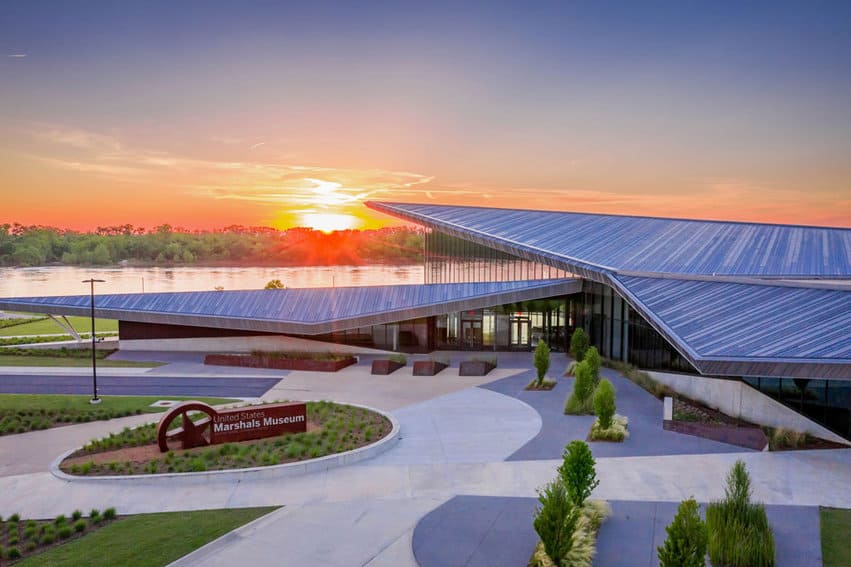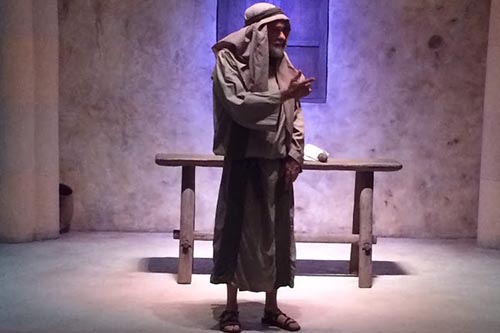
Learn the Real story of the Old West with a visit to Fort Smith and the New US Marshals Museum
By Mark Stachiew

When you enter the stunning new United States Marshals Museum in Fort Smith, Arkansas, forget about the Hollywood version of Old West history that you thought you knew, because this national museum aims to tell the real story, warts and all, of one of America’s most venerable law enforcement agencies.
Fort Smith was not chosen at random as the location for this state-of-the-art, 55,000-square-foot national museum that opened its doors for the first time this summer.
For a time, Fort Smith was an outpost on the edge of the American frontier.
Oklahoma Across the River
Across the Arkansas River where the museum was built lies modern-day Oklahoma, but in the 19th century it was not yet part of the United States and was known as Indian Territory. During this violent period in the nation’s history, more U.S. Marshals serving in Fort Smith died in the line of duty than at any other time or in any other place.
“We think of this narrative of history being pretty static and that there are good guys and bad guys, but that’s not always the case. There are many shades of gray so the Marshal Service has made a great point of not allowing us to just portray them as the good guys throughout history,” said museum president and CEO Ben Johnson during a

recent tour.
As an example, Johnson drew our attention to a display in the museum’s introductory gallery that explains how the Marshal Service was responsible for enforcing parts of the Fugitive Slave Act before the U.S. Civil War. He then walked us over to an area which tells the story of one of the deadliest days in the service’s history when six marshals were killed in a clash in what was then called Indian Territory in the 1870s.
“Most of this is Cherokee Nation related, so they had a hand in crafting the language, vetting the stories, making sure that we’re telling as many different sides as possible,” he explained.

Interactive Elements of the Museum
As for it being just an Old West museum, Johnson said nothing could be further than the truth. While it does feature plenty of interesting and innovative interactive elements that tell that side of marshals history, it also tells more modern stories like the agency’s role during the nation’s civil rights struggles and recent clashes with anti-government groups like Ruby Ridge and the Oklahoma City bombing.
Johnson expects those exhibits to be controversial for some visitors as there is a segment of the American population which remains antagonistic to the federal government.
“This is the only job I’ve ever had where I’ve actually had to report Facebook comments to federal law enforcement which I try not to think about every day.”

For visitors who want to delve deeper into the region’s Old West history, a stop at the nearby Fort Smith National Historic Site is a must. This outpost on the edge of what was then America’s westernmost border tells a fascinating story of that era.
Why the Museum is in Fort Smith
“We lost over 70 deputy marshals and posse members out of Fort Smith Arkansas. That’s more than any place in United States history so if you want to know why the U.S. Marshals Museum is there, it’s because of this place,” explained Park Ranger Cody Faber during a tour of what remains of the 19th century fort.
Faber said that they have a lot of fascinating stories to share that are related to exhibits at the Marshals Museum, but he said that not all of them were heroic which is why he takes great pains to point out the darker moments of the fort’s past which for much of its history was a used as a prison and a courtroom.
“As a nation, we’ve been spending the past few years talking about statues and flags. To some people, this building is a statue and a flag. To them, we were incarcerating people here who were technically within the nation and trying him in a courtroom by U.S. constitutional law when they weren’t even protected by it,” he said.

Life on the Frontier
As Faber walked us through one of the few buildings that remain standing at the fort, he enthusiastically weaved fascinating stories about life on the frontier and the bad people that were incarcerated there. We visited a recreation of the courtroom where we play-acted a trial, demonstrating how some of the things about America’s legal system have changed and how some have stayed the same.

“During our tour, you’ll hear me talk about genocide, the removal process of Native Americans, racism, capital punishment and firearms issues. These are subjects that they dealt with at that time and that we’re still talking about. Because we’re broaching them within the context of history, we get to have some great conversations with visitors that are not in all caps on Facebook.”
Fort Smith was where one of the Old West’s most famous characters held court, Judge Isaac Isaac Parker, who’s mostly remembered today as ‘The Hanging Judge.’ Despite the nickname that was thrust upon him by the newspapers of the day, Faber dispelled the myth that Parker was bloodthirsty.
A Vicious Man?
“I have people come in here and say, ‘Man, I heard he was vicious,’ but he was not. He actually decried the death penalty,” said Faber. “There are tens of thousands of human stories of the people who came through here and Parker is just one of them.”
Visitors who want to spend more time delving into Fort Smith’s history can explore several other remnants of this boisterous border town’s colorful past.
One example is the beautifully restored Clayton House, the Victorian-era home of William Clayton, who was Judge Parker’s federal prosecutor.
There’s also the Fort Smith Museum of History which tells the broader story of the town beyond just the Old West era, but no visit to Fort Smith would be complete without a stop at “Miss Laura’s Social Club.”
It’s the only former house of ill repute listed on the U.S. National Register of Historic Places.
This Victorian bordello has been fully restored to its original grandeur and while you can get a tour of the place, it also doubles as the Fort Smith’s visitor center so if you want to know more about all of the fun and interesting things there are to see and do in this pleasant Arkansas town, this is the best place to start your visit.
Plan your trip to Fort Smith at https://fortsmith.org.
 Mark Stachiew is a Montreal-based travel journalist who has been exploring and writing about the world for more than 30 years
Mark Stachiew is a Montreal-based travel journalist who has been exploring and writing about the world for more than 30 years
- Arezzo, Tuscany: A Stunning Find - September 3, 2024
- Fall Clothing for Your Travels - August 30, 2024
- Mekong Chronicles: The River That Shaped Southeast Asia - August 28, 2024






Great article! Thanks!